|
Douglas AC-47
by
Andrew Garcia
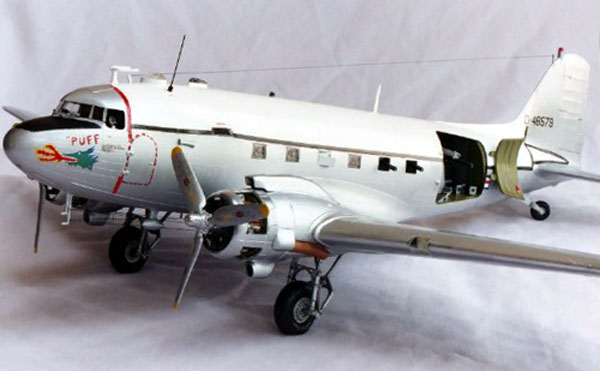 |
|
AC-47 |

HyperScale is proudly supported by Squadron.com
The C-47 was America’s military version of the Douglas DC-3. Like many other
aviation breakthroughs’, the new Pratt & Whitney and Wright engines under
development in the 1930’s permitted new aircraft designs to become a reality and
resulted in the DC-1. Testing in 1933 revealed the aircraft; a DC-1, reached 227
mph – the same performance achieved by contemporary racing aircraft! The U.S.
Army Air Corps bought a single DC-2 for evaluation in 1935. This led to some
production orders and modifications such as the rear cargo-loading door.
The evolution continued until the first DC-3 was delivered to
American Airlines on the 18th of August 1936. By 1937 Douglas was turning out 36
units a month. The need for greater load carrying resulted in the C-47 military
transport specification requiring Pratt & Whitney R-1800-92 engines. Production
of these aircraft totaled 5,253 during the WWII years. The last production C-47
was delivered to the USAAF on the 13th of October 1945. Although built as
C-47B’s, the vast majority were converted to C-47D’s by the simple process of
removing the engine blowers when it was determined their engine troubles were
cured by this change. This venerable aircraft can still be found flying today.
|
Monogram 1/48 C-47
Skytrain (Dakota IV) |
First released in 1978 as a USAAF paratrooper model (Kit # 5607)
complete with a group of jump-ready troopers, the kit has been a good seller
with only a few completed models appearing at shows and contests. It was
re-released in 1989 and also released as a civilian airliner version with the
rear-cargo door eliminated as is appropriate for this version. I was fortunate
to see one built by Rodney Williams at a San Jose, California IPMS contest in
the mid-1980’s and knew one day I would be building a D-Day invasion model like
his. This resulted in the fortunate purchase and storage of a few Monogram
C-47’s for future use.
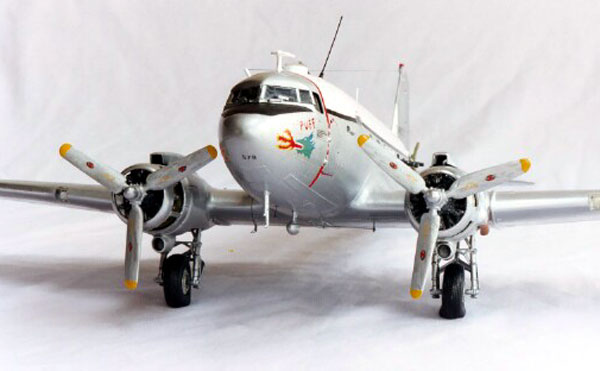
A terrific kit build of a Revell-Monogram Do-217E-5 by Nick J. Wigman featured
in the April 2002 Scale Aviation Modeler International (Vol. 8 Issue 4) issue
was the final impetus to my starting a C-47 project. Nick had done what I was
thinking about doing – incorporating the Aires resin engines into a kit build.
The Aires - # 4032 Pratt & Whitney R-1830 Late Version engines are little gems.
They are exquisite in detail, easy to construct and stunning when finished.
I had been thinking about building the C-47 in D-Day markings and incorporating
the Aires resin engines into a building project for some time. In 2001 my eldest
son graduated from the U.S. Army Airborne school and I knew the time had come to
get this project underway after hearing many stories about his experiences in
“para” training. He had a touching story about three men who were in the first
graduating class of the U. S. Army Airborne school, during WWII, addressing his
graduating class at Ft. Benning, on the day he received his Airborne wings.
After this memorable story, the Monogram C-47 came down from the “pending” shelf
and research started. However, after studying a number of references I decided
to build the three AC-47 gunships on the Microscale decal sheet and postpone the
C –47 Paratrooper D-Day kit for the next building cycle. The photos in
International Airpower Review Vol. 4 “USAF Gunships in Vietnam Part 1” were so
fantastic, I decided to build the AC-47’s to get some C-47 building experience
before I build the D-Day Paratrooper version.
The Monogram kit builds easily out of the box. It does have a few construction
challenges such as the wing to fuselage join and the closing of the two fuselage
halves due to a slightly oversized internal component. The next most important
part of the building effort, after the Monogram kit, is the Meteor Productions
Cutting Edge Modelworks CEC48040 AC-47D Gunship Conversion Set, Spooky/Puff the
Magic Dragon. This made it all possible. It is typical Cutting Edge quality –
that is, superb bubble-free resin, incredible detail and ease of construction
with a very clear and content rich instruction sheet (Thank you Meteor!).
The Aires - #4032 Pratt & Whitney R-1830 Late Version resin engines were easy to
build and have incredible detail. I cut away the side access panels on the
engine cowlings to expose the beauty of the Aires engines. This left me with the
problem of mounting the engines. I researched the C-47 and found a few superb
cutaway drawings showing good views of the engine mounts. The references were so
good I realized it would be best left up to the Scott Battistoni’s of the world
(the creator of most of the master mold’s at Meteor) who have the talent to
craft such components. I opened a hole inside the cowling and firewall and used
Milliput epoxy putty for a mounting. It worked despite not being the most
elegant solution. I would love to see the likes of Cutting Edge, Aires, CMK or
Verlinden provide C-47 engines and mountings for a future build.
Additional components I added were the Squadron - #48052 resin wheels, modified
props and navigator window. I had to modify the kit props since the kit provided
WWII style thin props. This gave way to a full paddle blade prop in the
1950/60’s. The reference texts clearly show these and they are natural metal on
the planes featured on the Microscale sheet and not the traditional flat black
props. For the gunship version I also had to add a side Navigation window since
it is not part of the Monogram C-47.
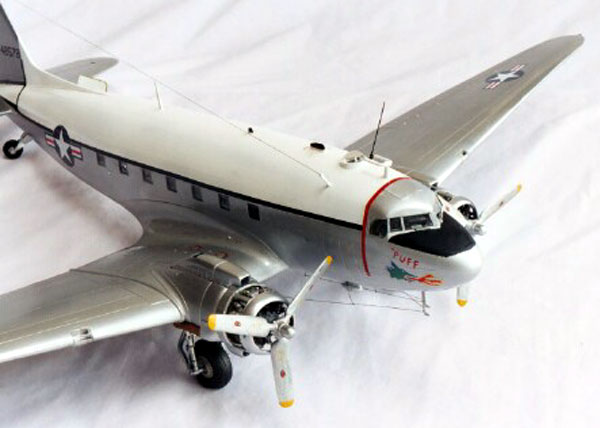
The props were a temporary fix using the kit props as a foundation. I added some
evergreen plastic, cyano glue and Milliput epoxy putty to rough out some paddle
shaped blades using photos from the reference books. The props were painted
aluminum per color photos on pg. 120 + 122 International Air Power Review. I
will remove them and replace them with new props when Meteor or Blackbox comes
out with the correctly shaped resin props. The cockpit has no etched metal
seatbelts, which I always add to a kit, because they can’t be seen. The most
important cockpit area enhancements are the Cutting Edge resin gunsight and some
scratchbuilt (using metal from the Aires P & W engine etched metal fret) metal
wiper blades on the front cockpit windows.
There are many, many antennas on the top and bottom of the FC/AC-47 aircraft
with no one standard so you need to study your reference photos. Cutting Edge
though provides most of the needed antennas in their resin set.
The aircraft on which the “Puff the Magic Dragon” nickname was
first carried was 43-48579, one of a trio of original FC-47D’s operated by the
1st ACS. This aircraft was built during World War II as a C-47B-5-DK. The
aircraft was later modified to C-47D standards (its superchargers having been
removed). The conversion was done by Air International, Inc. in Miami, to a
FC-47D standard. When 43-48579 was assigned to the 1st ACS, this airframe was a
mail courier aircraft (in early 1964) and initially maintained its gloss white
upper fuselage with natural metal finish on the rest of the airframe.
By late 1965 “Puff” had been re-sprayed in SEA camouflage, over which its nose
art was reapplied. Also, the aircraft had been officially designated “FC-47” for
Fighter/Cargo-47, but after an outcry from some pilots, the nomenclature was
changed to “AC-47” representing the “attack” designation. Approximately 53
FC/AC-47D gunships were built.
White “ballistic cloth”, which was a kevlar tarp, was hung on the “gun” side of
later aircraft to prevent AA fire from hitting the ammunition supply. It was not
in use at the time this model represents.
The aircraft is outfitted with three SUU-11A 7.62mm minigun pods with GAU-2B/A
guns fitted to the late production racks. They are from the Cutting Edge resin
update set.
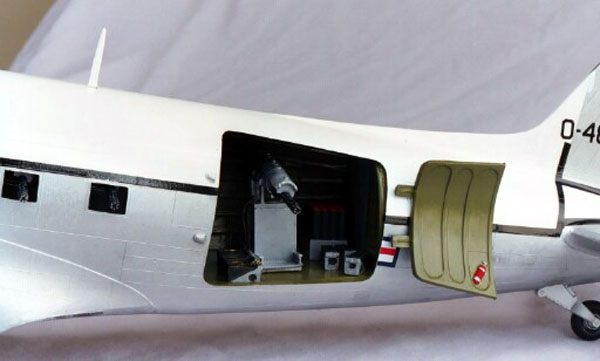
I have the next two AC-47’s from the Microscale decal sheet under construction.
One is the FC-47D S/N 44-8991 “The ‘.30-Caliber Kit” Gunship (Bien Hoa, Vietnam
1965) and the third is AC-47D S/N 43010, 432nd TRW “Spooky Detachment”4th SOS,
Udorn RTAB Thailand 1969 in SEA camouflage.
S/N 43010 aircraft was one of the last AC-47 gunships. It wears the final SEA
camouflage paint scheme and was armed with SUU-11A 7.62mm minigun pods with
GAU-2B/A guns fitted to the late production racks. An extra window was cut in
front of the rear access doors for the third minigun to provide unrestricted
access through the rear doors. This was accomplished by moving the third gun
from the doorway exit into a new “window” opening. I will show this in a future
Hyperscale write-up.
The best color photos and references were found in International Airpower Review
Vol. 4 “USAF Gunships in Vietnam Part 1” page 124. A color profile of this
aircraft can be found in Gunships – A Pictorial History of Spooky – Squadron
Signal publications # 6032 on page 28, and a photo on page 14. Both references
are authored by Larry Davis.
As more of the next generation gunships, the AC-119K Stinger and AC-130A Spectre
Gunships became available the AC-47D was phased out of USAF inventory. The final
AC-47D mission was flown on 30 November 1969. This was the final mission for the
4th SOS and ended USAF AC-47 operations in South Vietnam.
I used SnJ and Testors Metalizer for the natural metal finish
sealed with Future floor wax. The white upper surface is Gunze Flat white since
its opacity is better than the gloss. The entire model was sprayed with Future
floor wax before and after decaling. The cockpit and internal fuselage was
painted Zinc Chromate green using Gunze acrylics.
The exterior of the model was sprayed with several light coats of SnJ Aluminum
Metallizer. I buffed the natural metal finish with Aluminum SnJ powder. The
upper nose was painted flat black using Monogram paints. The propellers were
natural metal based on color reference photos from International Airpower Review
Vol. 4 “USAF Gunships in Vietnam Part 1” . I used Testors aluminum metalizer for
the props. The antenna wire was made from invisible sewing thread painted with
Monogram flat black.
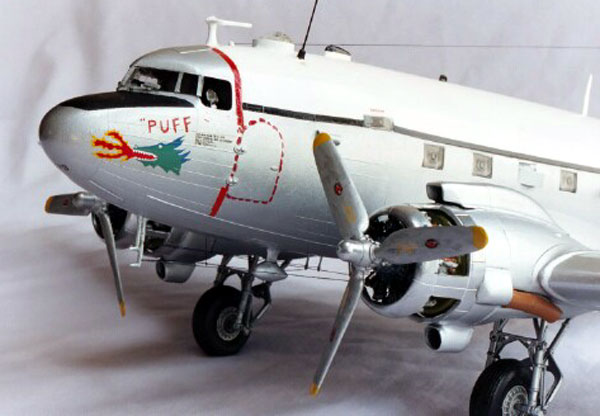
The decal is a Microscale (pre-Superscale) 48-251 sheet, Gunships AC-47’s and
AC-130A, decal # 3.
Some stencils were taken from the Monogram C-47 kit and my spares box .
One last suggestion – if you don’t have a copy of the International Air Power
Review – get it! Airlife Publishing will be releasing a bound issue of volumes
1-4. The color photos, richness of detail shots and unique photography will make
it one of your favorite references. It certainly was the key reference for my
C-47 Gunship trilogy.
-
International Airpower Review Vol. 4
“USAF Gunships in Vietnam Part 1 pages 112- 125.
-
Gunships – A Pictorial History of
Spooky – Larry Davis - Squadron Signal publications # 6032 , 1982.
-
American Warplanes of World War II –
Douglas C-47 Skytrain - David Donald -- -AIRtime Publishing Ltd. 1995 pgs. 102 –
109.
-
Douglas DC-3 Dakota Super Profile –
M.J. Hooks – Haynes Publications 1985 Pages 6-7 have a two-page cutaway drawing
of the interior components including engine mounts.
-
Replic No. 121 September 2001 DC-3
Dakota with color photos in photoscope section pages 24- 34.
-
Forge of Freedom – V. Dennis Wrynn
Motorbooks International 1995, pages 120-124.
-
WWII Pacific War Eagles – Jeff Ethell
– has many color photos of C-47’s.
-
WWII Eagles In Original WWII Color –
Jeff Ethell
-
The Mighty Eighth in Color – Freeman -
color photos of C-47’s and some with D-Day markings.
-
The Ninth Air Force in Colour -
Freeman – many color C-47 photos.
-
Aircraft Profile No. 96 Douglas DC-3
-
Douglas DC-3 The Survivors – Kengo
YamamotoAirlife Publishing 2000 - all color photos
All images were taken indoors with
available light with a Nikon FTN camera set at F-stop 32 or 22 using a Micro-Nikkor
55mm lens. Other camera settings were as follows: Kodak 200 ISO film speed, 1
sec shutter speed using a tripod. Digital Images were obtained during film
processing by selecting the digital CD option as well as prints. This provides
“.jpg” format files for digital images on a CD or floppy disk.
Click the thumbnails below to view
larger images:
Model, Images and
Article Copyright © 2002 by Andrew Garcia
Page Created 26 October 2002
Last updated 04 June 2007
Back to HyperScale Main Page
Back to Features Page |
Home
| What's New |
Features |
Gallery |
Reviews |
Reference |
Forum |
Search